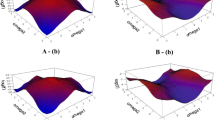Abstract
Spatial averages are robust components of data sets, and therefore well suited as starting points for trend analysis. A natural way of constructing a global trend surface from average values, is to use a subdivision algorithm. This procedure will in some cases reproduce exactly the drift of the data set. Numerical experiments on multibeam echo sounder data show that residual data sets contain no long range correlations. In addition, a variogram analysis clearly identifies the amount of noise in the original data.
Similar content being viewed by others
References
Bartier, P. M., and Keller, C. P., 1996, Interpolation for geochemical surface reconstruction incorporating topographic catchment definitions: Math. Geol., v. 28, no. 3, p. 253–273.
Bjørke, J. T., and Nilsen, S., 2005, Derivation of quality parameters for terrain models: Examples from seafloor and landscape mapping, in Hauska, H., and Tveite, H., eds., Proceedings of the 10th Scandinavian Research Conference on Geographical Information Science: Universitetsservice, Stockholm, p. 31–37.
Boneva, L. I., Kendall, D., and Stefanov, I., 1971, Spline transformations—three new diagnostic aids for the statistical data analyst: J. R. Stat. Soc. Ser. B—Stat. Method., v. 33, no. 1, p. 1–70.
Chilès, J. P., and Delfiner, P., 1999, Geostatistics—Modeling spatial uncertainty: Wiley-Interscience, New York, 672 p.
Cohen, A., Daubechies, I., and Feauveau, J.-C., 1992, Biorthogonal bases of compactly supported wavelets: Commun. Pure Appl. Math., v. 45, no. 5, p. 485–560.
Cressie, N. A. C., 1993, Statistics for spatial data: Wiley, New York, 900 p.
Deutsch, C. V., and Journel, A. G., 1998, GSLIB—Geostatistical software library and user's guide, 2nd ed.: Oxford University Press, New York, 369 p.
Donoho, D., 1993, Smooth wavelet decompositions with blocky coefficient kernels, in Schumaker, L. L., and Webb, G., eds., Recent advances in wavelet analysis: Academic, New York, p. 1–43.
Journel, A. G., 1985, The deterministic side of geostatistics: Math. Geol., v. 17, no. 1, p. 1–15.
Kongsberg, 2004, Kongsberg Maritime: [Online]. Available at: http://www.km.kongsberg.com.
Leick, A., 1995, GPS—Satellite surveying, 2nd. ed.: Wiley, New York, 560 p.
Matheron, G., 1969, Le Krigeage Universel: Recherche d'Estimateurs Optimaux en Présence d'une Dérive (Universal kriging). Fascicule 1, Les Cahiers du Centre de Morphologie Mathématique, Edité par l'Ecole Nationale Supérieure des Mines de Paris, Fontainebleau, France, 83 p.
Olea, R. A., 1999, Geostatistics for engineers and earth scientists: Kluwer Academic, Boston, 303 p.
Schoenberg, I. J., 1973, Splines and histograms, in Meir, A., and Sharma, A., eds., Spline functions and approximation theory: Birkhäuser, Basel, p. 277–327.
Sweldens, W., and Schröder, P., 2000, Building your own wavelets at home, in Klees, R., and Haagmans, R., eds., Wavelets in the geosciences: Springer-Verlag, Berlin, p. 72–130.
Tchamitchian, Ph., 1987. Biorthogonalité et théorie des opérateurs: Revista Mathematica Iberoamericana, v. 3, p. 163–190. Available at http://www.uam.es/departamentos/ciencias/matematicas/ibero/.
Tobler, W. R., 1979, Smooth pycnophylactic interpolation for geographical regions: J. Am. Stat. Assoc., v. 74, no. 367, p. 519–530.
Wackernagel, H., 1998, Multivariate geostatistics, 2nd ed.: Springer-Verlag, Berlin, 291 p.
Warren, J., and Weimer, H., 2002, Subdivision methods for geometric design—A constructive approach: Morgan Kaufman, San Francisco, 299 p.
Author information
Authors and Affiliations
Corresponding author
Rights and permissions
About this article
Cite this article
Bjørke, J.T., Nilsen, S. Trend Extraction Using Average Interpolating Subdivision. Math Geol 37, 615–634 (2005). https://doi.org/10.1007/s11004-005-7309-4
Received:
Accepted:
Issue Date:
DOI: https://doi.org/10.1007/s11004-005-7309-4




